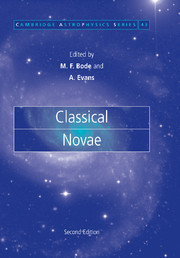Book contents
- Frontmatter
- Contents
- List of contributors
- Preface to the first edition
- Preface to the second edition
- List of symbols
- 1 Novae: an historical perspective
- 2 Properties of novae: an overview
- 3 The evolution of nova-producing binary stars
- 4 Thermonuclear processes
- 5 Nova atmospheres and winds
- 6 Observational mysteries and theoretical challenges for abundance studies
- 7 Radio emission from novae
- 8 Infrared studies of classical novae
- 9 Optical and ultraviolet evolution
- 10 X-ray emission from classical novae in outburst
- 11 Gamma-rays from classical novae
- 12 Resolved nebular remnants
- 13 Dust and molecules in nova environments
- 14 Extragalactic novae
- Object index
- Subject index
2 - Properties of novae: an overview
Published online by Cambridge University Press: 10 October 2009
- Frontmatter
- Contents
- List of contributors
- Preface to the first edition
- Preface to the second edition
- List of symbols
- 1 Novae: an historical perspective
- 2 Properties of novae: an overview
- 3 The evolution of nova-producing binary stars
- 4 Thermonuclear processes
- 5 Nova atmospheres and winds
- 6 Observational mysteries and theoretical challenges for abundance studies
- 7 Radio emission from novae
- 8 Infrared studies of classical novae
- 9 Optical and ultraviolet evolution
- 10 X-ray emission from classical novae in outburst
- 11 Gamma-rays from classical novae
- 12 Resolved nebular remnants
- 13 Dust and molecules in nova environments
- 14 Extragalactic novae
- Object index
- Subject index
Summary
Introduction
Although no two novae show exactly the same properties or development during eruption, there are systematics in the overall population of novae that assist in the interpretation of the physics underlying their behaviour and their relationship to other systems of stars. Furthermore, some of these properties are of value in other areas, such as distance indicators for extragalactic research. Here we give a general introductory overview of the general properties of novae, derived largely from ground-based observations; later chapters add more detail and extend the wavelength range.
Frequency and Galactic distribution of novae
The frequency of classical nova discoveries over the past century, corrected for non-uniformity of coverage in time, is shown in Table 2.1 (Duerbeck, 1990). In the range 4 ≤ mv ≤ 6 the values do not increase as fast as expected, showing that many bright novae go undetected. At fainter magnitudes the increase is due to the contribution of novae in the Galactic bulge. The total mean detected nova rate is ∼3 yr-1. There are so many factors that lead to incompleteness in nova searches (seasonal, weather, sky coverage biased towards the Galactic bulge, missed fast novae) that it is possible to conclude that Table 2.1 shows the few novae that were actually detected from an observable number of ∼12 yr-1 (Liller & Mayer, 1987).
- Type
- Chapter
- Information
- Classical Novae , pp. 16 - 33Publisher: Cambridge University PressPrint publication year: 2008
- 38
- Cited by



